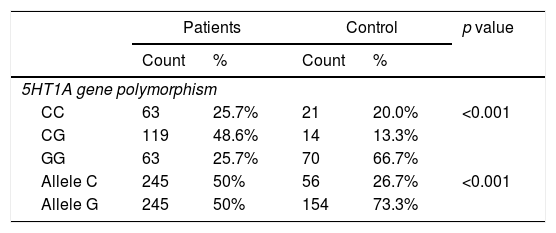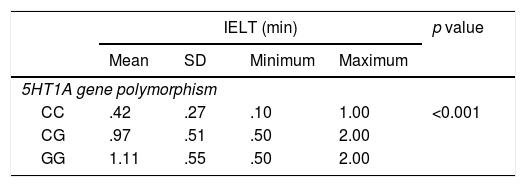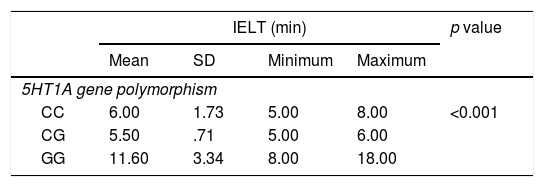Lifelong premature ejaculation (LPE) is identified as the inability to delay ejaculation for more than 1min after vaginal penetration occurring on all or almost all sexual experiences together with feelings of frustration of both the patient and his partner with avoidance of sexual intimacy. Recently, a role for (HTR1A)-C (1019) G gene polymorphism in patients with LPE was postulated.
Materials and methodsThree hundred and fifty participants were prospectively enrolled in this study. They were recruited from the outpatient clinic of Andrology & STDs Department Cairo University from December 2015 to January 2017. Two hundred and forty-five of them were suffering from lifelong premature ejaculation joined this study, in addition to 105 controls. We instructed the wives of the patients to measure the intra-vaginal ejaculation latency time (IELT) of the first intercourse only using a stopwatch for 1 month. Genotyping was performed at the end of the study.
ResultsThe results showed that the majority of the patients were CG, while; the controls were GG. This difference revealed a statistically significant association (p-value<0.001). A highly significant statistical association was found between the studied gene polymorphisms and the IELT among cases (p-values=0.001).
ConclusionThe study replicated the potential role of 5HT-1A receptor gene polymorphisms in patients with lifelong premature ejaculation.
La eyaculación precoz permanente (LPE) se identifica como la incapacidad para retrasar la eyaculación más de 1min después de la penetración vaginal, que en todas o casi todas las experiencias sexuales provoca sentimientos de frustración tanto en el paciente como en su pareja y conduce a la abstención de las relaciones sexuales. Recientemente, se ha propuesto que el polimorfismo del gen (HTR1A)-C (1019) G tiene un papel en pacientes con LPE.
Materiales y métodosSe incluyó a 350 participantes en este estudio. Se los reclutó en la clínica ambulatoria del Departamento de Andrología y ETS de la Universidad del Cairo entre diciembre de 2015 y enero de 2017. Doscientos cuarenta y cinco de ellos con eyaculación precoz permanente se incorporaron a este estudio, además de 105 controles. Instruimos a las esposas de los pacientes para medir el tiempo de latencia de la eyaculación (TLE) intravaginal de la primera relación sexual utilizando solamente un cronómetro durante 1 mes. La genotipificación se realizó al final del estudio.
ResultadosLos resultados mostraron que la mayoría de los pacientes fueron CG, mientras los controles fueron GG. Esta diferencia reveló una asociación estadísticamente significativa (valor de p<0,001). Se encontró una asociación estadística muy significativa entre los polimorfismos de los genes estudiados y el TLE entre casos (valores de p=0,001).
ConclusiónEl estudio reprodujo el papel potencial de los polimorfismos del gen del receptor de 5-HT1A en pacientes con eyaculación precoz permanente.
In 2008, the international society for sexual medicine (ISSM) depicted an operational definition for lifelong premature ejaculation (LPE) as the inability to delay ejaculation for more than 1min after vaginal penetration occurring on all or almost all sexual experiences together with feelings of frustration of both the patient and his partner with avoidance of sexual intimacy.1 The prevalence of lifelong premature ejaculation is expected not to exceed 4% based on two surveys, involving five nations, of intravaginal ejaculation latency time (IELT) and the ISSM and DSM, fifth edition definitions.2,3 Hoyer et al. (1994) demonstrated that there are at least fourteen types of mammalian 5-HT receptors at which selective serotonin reuptake inhibitors (SSRI) act to induce increases in 5-hydroxy tryptamine (5-HT).4 They were classified into seven families. All are G protein-coupled receptors, with the exception of the 5-HT3 receptor, which is a ligand-gated ion channel.4 5-HT1 receptors couple to G proteins of the Gi/o class (as well as possibly Gz), and inhibit adenylyl cyclase.4 Noteworthy, activation of the 5-HT1A receptor resulted in inhibition of adenylate cyclase, increased K+conductance and in some cell types, increases in intracellular [Ca2+].5,6 However, under some conditions 5HT-1A receptors can conversely activate adenylyl cyclase as insulin growth factor 1 (IGF1) was interestingly increased by elevated C-AMP in cultured embryonic mouse mandibular mesenchymal cells treated with receptor agonists.7,8 Several studies reported that ejaculation is facilitated by selective 5-HT1A receptor agonists in rats and animal research has shown that selective 5-HT1A receptor agonists facilitate ejaculation latency times.9,10
Recently, Janssen and his colleagues postulated that (HTR1A)-C (1019) G gene polymorphism plays a role in patients with LPE.11 We aimed in this study to evaluate the prevalence of 5HT1A receptor gene polymorphisms among Egyptian patients with lifelong premature ejaculation.
Patients/subjects and methodsParticipants recruitment and study designThree hundred and fifty participants were totally recruited in this prospective study. Two hundred and forty-five cases with lifelong premature ejaculation joined this study; the remainders were controls.12 They were recruited from the outpatient clinic of Andrology & STDs Department Cairo University from December 2015 to January 2017.
The cases suffered from lifelong premature ejaculation of <1min in all or almost all intromissions since their first sexual experience with negative emotional consequences on them and their partners. Approval of the local ethical committee was obtained after getting in writing informed consent from the participants about the purpose of the study that conforms to Helsinki declaration 1964.
Inclusion criteria of the patientsAll the recruited patients were potent together with stable relationship for at least 1 year. Additionally, all of them were unable to delay ejaculation for more than 1min on all or almost all intromissions since their first sexual encounter.1
Exclusion criteria of the patientsAll patients who suffered from erectile dysfunction (IIEF score<21), chronic systemic illnesses (diabetes mellitus, liver cirrhosis, chronic renal failure), neurologic deficits such paraplegia or administration of antipsychotic medications that may impair ejaculatory function were excluded from the study. Also, the patients who use topical anesthetics or condoms were excluded as these measures may interfere with the accuracy of IELT measurement. Finally, all the patients who received selective serotonin re-uptake inhibitor (SSRIs) for premature ejaculation were also excluded to avoid any potential effect of SSRIs on the polymorphisms that were evaluated.
Inclusion criteria of the controlsThey were potent individuals complaining of infertility who attend our outpatient infertility clinic.
Assessment of the patientsAll the participants were Egyptian and married.12 We used the validated Arabic version of the International Index of Erectile Function to determine the level of erection of the enrolled patients and instructed the partners of the cases to measure the IELT of the first intercourse only.13 In addition, the partners of the cases were instructed to measure the time taken from intromission till the sense of ejaculation inside their vagina using a stopwatch for 1 month. The patients were diagnosed as lifelong premature ejaculators by using the IELT and the complaint of frustration and avoidance of sexual intimacy because of their problem.14,15 The patients were supplied with an ejaculatory diary to record the frequency of the intercourse and the intravaginal ejaculatory latency time (IELT) during this month.
Genotyping (DNA isolation and polymerase chain reaction (PCR) analysis)Venous blood was drawn and immediately stored at −70°C until DNA extraction was performed with Wizard®Genomic DNA Purification Kit (Promega, USA). The polymorphism 5-HTTLPR in the promoter region of the gene was analyzed after polymerase chain reaction (PCR) amplifications of the fragments using primers 5-HTTLPRF (5′-GGCGTTGCCGCTCTGAATTGC-3′) and 5-HTTLPRR (5′-GAGGGACTGAGCTGGACAACCCAC-3′).16 PCR was performed in a total volume of 25ml containing 25–50ng genomic DNA, 0.3–0.4mmol/l primers and 0.625U Taq DNA polymerase in PCR Master Mix (Promega, Madison, WI, USA). Amplification of 5-HTT polymorphic regions consisted of 35 cycles of 95°C for 30s, 61°C for 30s and 72°C for 60s, followed by a final extension at 72°C for 7min. We used the primers for the PCR that were previously designed.17 PCR products were digested with HpyCH4 IV (New England Biolabs_ Inc.). One uncut band of 182bp corresponded to the C allele, while two bands of 158 and 24bp corresponded to G allele. PCR products were separated on 3% agarose gel and visualized with ultraviolet light after ethidium bromide staining.18,19
Statistical methodsData were coded and entered using the statistical package SPSS (Statistical Package for the Social Sciences) version 23. Data were summarized using mean, standard deviation, median, mode, minimum and maximum in quantitative data and using frequency (count) and relative frequency (percentage) for categorical data. Comparisons between quantitative variables were carried out using the nonparametric Kruskal–Wallis and Mann–Whitney tests.20
For comparing categorical data, chi-square (χ2) test was performed. p-Values<.05 were considered as statistically significant.
ResultsAll the patients and the controls were Egyptians and married.12 The mean age of the cases and controls were 29.34±6.01 and 28±5.44 respectively and this did not show a statistically significant difference (p 0.13).12 The mean IELT of the cases and the controls were 0.87±.53seconds and 9.7±3.96minutes and this difference was statistically highly significant (p<0.001).12 Finally, the mean IIEF score in the cases and the controls were 24.06±1.00 and 24.07±.96 respectively and this did not show a statistically significant difference (p 0.93).12 The current study revealed that the frequency of the genotypes of 5 HT-1A receptor gene polymorphisms in the patients was as follow: 63 CC (25.7%), 119 CG (48.6%), 63 GG (25.7%). The frequency of the genotypes of this gene in the controls was as follow: 21 CC (20%), 14 CG (13.3%) and 70 GG (66.7%) respectively (see Table 1). This difference revealed significant association (p<0.001). Both alleles were equally represented in the patients. Meanwhile, the frequency of these alleles in the controls was as follow: 56C (26.7%) and 154 G (73.3%) respectively. This difference also revealed significant association (p<0.001) (see Table 1). Additionally, this study demonstrated highly significant association between this gene polymorphism and the IELT in the cases (CC (.42±.27), CG (.97±.51), GG (1.11±.55), p<0.001, respectively) and the controls (CC (6±1.73), CG (5.5±.71), GG (11.6±3.34), p<0.001, respectively) (see Tables 2 and 3).
Frequency of the polymorphism in the patients and the controls.
| Patients | Control | p value | |||
|---|---|---|---|---|---|
| Count | % | Count | % | ||
| 5HT1A gene polymorphism | |||||
| CC | 63 | 25.7% | 21 | 20.0% | <0.001 |
| CG | 119 | 48.6% | 14 | 13.3% | |
| GG | 63 | 25.7% | 70 | 66.7% | |
| Allele C | 245 | 50% | 56 | 26.7% | <0.001 |
| Allele G | 245 | 50% | 154 | 73.3% | |
p-Value was calculated using Mann–Whitney test.
Waldinger et al. (1998) were the first to postulate the potential role of hyper functioning 5-HT1A receptors and/or hypo functioning 5-HT2C receptors in influencing the serotoninergic neurotransmission resulting in shortened intra-vaginal ejaculation latency time (IELT) of less than 2min in men with lifelong premature ejaculation (LPE).21 In the same context, Giuliano (2007) revealed that stimulation of the 5-HT 1a somatodendritic autoreceptors in the mesencephalic and medullary raphe is responsible for decreasing 5-HT release into the synapse and thereby reducing ejaculatory latency through a negative feedback mechanism.22 Also, he demonstrated that central injection of 5-HT and systemic injection of the 5-HT precursor 5-hydroxytryptophan led to delayed ejaculation in rats, as a result of increased activation of postsynaptic 5-HT 1b or 5-HT 2c receptors (or both).22
Till now, the exact mechanism of 5-HT 1a receptors in the ejaculatory process is unclear as they are located in different locations, such as the brain, raphe nuclei, spinal cord, and autonomic ganglia which may have different effects on the ejaculatory process.23,24 The current study demonstrated that the majority of the genotypes of the patients with LPE were CG, while; the controls were GG and this difference was statistically highly significant. The alleles were equally represented in the cases, while, in the controls the majority of the alleles were G. Also, this difference was statistically highly significant. Finally, this gene receptor polymorphism demonstrated significant association with the IELT in both cases and controls. In contrast, Janssen et al. (2014) revealed that the majority of the fifty four Dutch men with LPE were CC followed by CG and GG, respectively.11
Our findings can be explained on the basis that the polymorphism-1019C>G which is a single nucleotide polymorphism (SNP) that lies in the promoter region has a significant repressor activity that could lead to impaired repression of the HTR1A.25,26 Consequently, it could enhance the negative feedback inhibition of serotonergic Raphe neurons and lead to a lower serotonergic neurotransmission, causing a predisposition to depression and suicide.25,26 In the same context, several studies have suggested an association between GG genotype and major depression and anxiety and a lower response to SSRIs.27–29 Finally, we must mention some limitations of this study. Firstly, this study was not compliant with Hardy Weinberg equilibrium. Secondly, we did not assess all the types of polymorphisms of the gene of this receptor. Thirdly, we used only IELT and the feelings of frustration to establish the diagnosis of lifelong premature ejaculation. However, we were afraid to use other tools which might not be validated to be used among Arabic patients like the Egyptians. Also, the Arabic Index of Premature ejaculation has minimal validation.
ConclusionOur study is one of the few studies that evaluated the role of 5HT1A receptor gene polymorphism in the patients with LPE. This study replicated the influential role of this gene in the patients with LPE. Finally, we recommend future multi-center studies that evaluate the role of this gene deploying different races and ethnicities.
Ethical disclosuresProtection of human and animal subjectsThe authors declare that no experiments were performed on humans or animals for this study.
Confidentiality of dataThe authors declare that they have followed the protocols of their work center on the publication of patient data.
Right to privacy and informed consentThe authors have obtained the written informed consent of the patients or subjects mentioned in the article. The corresponding author is in possession of this document.
Conflicts of interestAll authors declare no conflict of interest.






